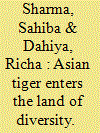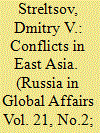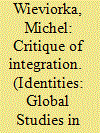|
|
|
Sort Order |
|
|
|
Items / Page
|
|
|
|
|
|
|
| Srl | Item |
| 1 |
ID:
145663


|
|
|
|
|
| Summary/Abstract |
‘Come, Make in India’, India’s Prime Minister has invited global firms to invest and manufacture in India and also to promote exports. As with this campaign, India has given a scope of promising growth to the companies which is also been seen to solve India’s multiple economic problems. Many countries have shown their interest to invest in India and one of them is South Korea. Now the question arises whether companies from South Korea in this competitive environment can mark their presence in India—a nation of cultural diversity, which can affect the initial start-ups, if ignored. Apart from the historical cultural ties, there are cross-cultural differences between South Korea and India. So, this paper aims to build up a study that brings together the parity and cross-cultural differences between South Korea and India. The paper opens with the discussion about the various historical, cultural and poetic relations to describe the scenario between the two countries, whereas for the analysis, a macro-meso-micro framework has been used to answer the research question. The three-level analysis helps this paper to see the overlooked influence of culture from a broader perspective. The results of the study reveal a list of cultural adaptations suited for South Korean start-ups to run businesses in India by avoiding the cultural threats and contribute to the existing literature. The study findings could be used by companies, marketers and practitioners to devise and re-vamp their strategies in India, and it will also serve as a cultural guide for them.
|
|
|
|
|
|
|
|
|
|
|
|
|
|
|
|
| 2 |
ID:
189869


|
|
|
|
|
| Summary/Abstract |
While the threats that turned Europe into the most explosive part of the
world in the last century appear to be quite relevant for Asia, the European-
style security institutions do not seem to work for Asia. The key reasons
are the historically embedded roots of the insecurity, more acute territorial
divisions, specific (non-Western) understanding of security, and ethnically-
driven separatist and irredentist movements. Also, as deglobalization
increases and the international system becomes less and less manageable,
East Asian countries tend to push harder for pursuing an autonomous
security policy.
|
|
|
|
|
|
|
|
|
|
|
|
|
|
|
|
| 3 |
ID:
134332


|
|
|
|
|
| Summary/Abstract |
The term ‘integration’ is a category used both in political discourse and in sociological analysis. In political discourse, in the public debate, it has become a magic word which accompanies repression when a political power is unable to deal with major difficulties, particularly in poor neighbourhoods. The so-called ‘models of integration’ are all failing, whether in the United Kingdom after the terrorist attacks of 2005, in the Netherlands after the murder of Theo Van Gogh and Pim Fortuyn, or in France after the riots of 2005. In political and social life, integration is far from able to account for realities or to implement public policies successfully. From a sociological perspective, integration is connected with approaches which are centred on society or the social system, much more than with those that deal with the subjectivity of individuals and their capacity for personal or collective action. This means that integration belongs much more to traditional sociological thinking than to the new contemporary sociological imagination.
|
|
|
|
|
|
|
|
|
|
|
|
|
|
|
|
|
|
|
|
|